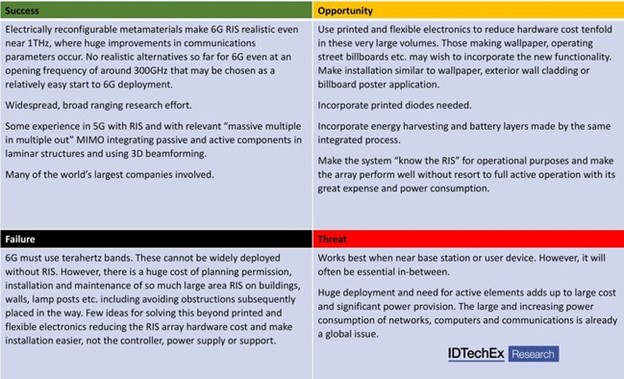Printed Electronics for 6G Smart Surfaces
It may take until 2030, but 6G Communications is coming to your smartphone.
According to Samsung, it will succeed with its holographs, instant downloads, etc., if it deploys smart surfaces everywhere. Surfaces must enhance and redirect the far-infrared “terahertz” beams as such emissions are not strong. A report that sizes and scopes this aspect is IDTechEx, “6G Communications Reconfigurable Intelligent Surfaces Roadmap, Materials, Market 2021-2045“.
Critical will be printed electronics, with line widths of a few microns, when the second stage 6G operating frequency reaches one terahertz level. 6G will likely start at 0.3THz. Initially, only conventional semiconductor components will be placed behind the printed metamaterial patterns, preferably printed in copper at one-tenth of silver material cost.
IDTechEx calculates that this new printed electronics opportunity will reach more than $7.5 billion by 2034. According to the report, some thin-film technologies used will be electrohydrodynamic, flexography, flexoprint and plate, photoresist, photolithography with etching, photocurable screen printing and embossed fine metal patterning.
Maximum benefits are planned at the second stage of 6G, including amplifying the beam before redirecting it, operating unpowered internet of things nodes, and even charging your smartphone from the beam. The new high electron mobility transistors HEMT and other components added must be made thinner and over-printed with metasurface patterning and much higher power must be produced and handled on film to achieve that endpoint.”
Reconfigurable Intelligent Surface RIS will consist of PIN diode-biased “semi-passive metasurfaces” at approximately one dollar per square meter given likely demand. 6G is as much a hardware challenge as a software and systems one. The 6G systems people may dismiss RIS as an easy, secondary matter, but RIS needs the most sophisticated skills of experts and many unsolved issues must be solved within the allotted timescale. That could lead to a great deal of high-added-value printing business and the associated demand for advanced materials.
For more information on this report, please visit www.IDTechEx.com/6GRIS or for the full portfolio of research available from IDTechEx please visit www.IDTechEx.com/Research.

